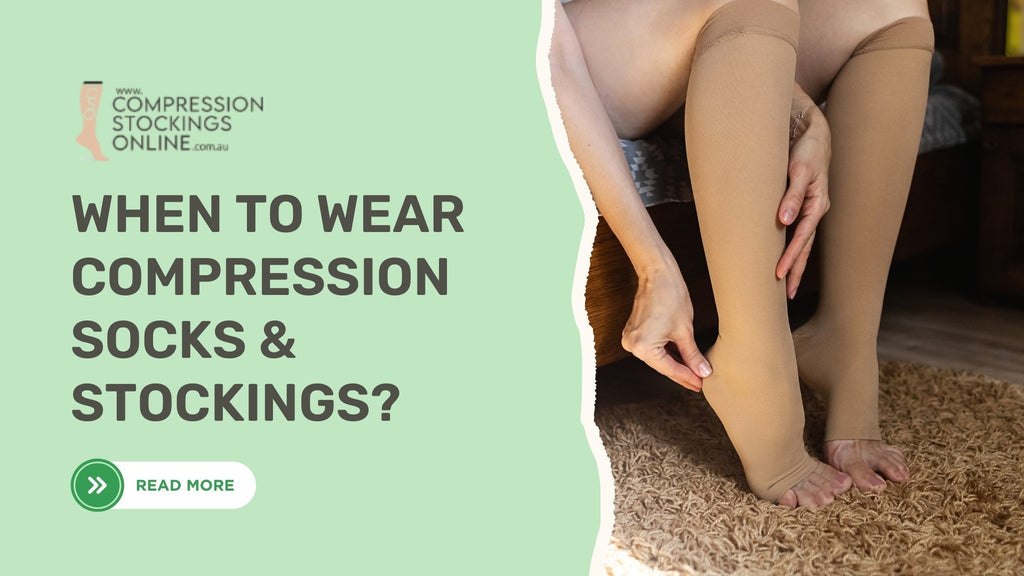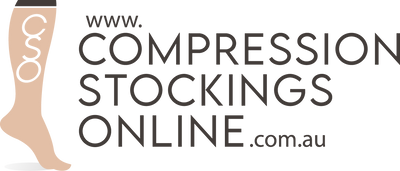
Long days on your feet, hours behind a desk, or sitting through a long-haul flight can leave your legs swollen, heavy, and tired. That’s where compression socks or stockings step in; they improve circulation, reduce fluid build-up, and ease discomfort.
In this article, we’ll look at when to wear compression socks, why they help, who benefits most, and how to pick the right fit for work, travel, pregnancy, recovery, and medical use. You’ll also learn quick safety tips and how to choose the right pressure and length for your needs.
Quick Rules
Here’s a simple guide you can keep in mind for everyday use:
- Workdays (sitting or standing): Put them on in the morning and keep them on until evening to prevent swelling and that heavy-leg feeling from long hours in one position.
- Travel (flights, car, or train over 3 hours): Slip on your travel socks before boarding or driving, wear them throughout the journey, and remember to move around and hydrate when you can.
- Exercise & recovery: Choose light compression for runs, rides, or gym sessions, then keep them on for 1–3 hours afterwards to ease soreness and speed up recovery.
- Pregnancy: In the later trimesters, daily wear from morning works best; take them off at night unless your doctor suggests otherwise.
- Medical use: For conditions like varicose veins, DVT, or post-surgery, always follow your clinician’s advice on the right pressure level and how long to wear them.
Why Compression Helps?
- Graduated pressure = faster blood return. Tighter at the ankle and gentler up the leg pushes blood back to the heart. That means less pooling, so less swelling and “heavy-leg” fatigue by the afternoon.
- Lower vein pressure. By easing the pressure inside surface veins, stockings calm varicose-vein and CVI symptoms (aching, throbbing) and support ulcer care plans by improving flow to the skin.
- Steadier calf “muscle pump.” During standing, sitting, or after exercise, compression reduces fluid leaking into tissues, so calves feel fresher and recover quickly.
See our guide on What Do Compression Stockings Do for a clear look at how they improve circulation and reduce swelling.
Who benefits? (conditions + when to wear?)
Varicose veins/spider veins
- When: Wear daily during waking hours; take off for sleep.
- Why it helps: Graduated pressure drops venous pooling, easing ache, throb, and ankle swelling by lowering surface vein pressure and improving return flow.
Chronic venous insufficiency (CVI)
- When: Every day, especially in the morning; add walking and calf raises.
- Why: Compression cuts venous hypertension, which reduces oedema and skin strain that leads to heaviness and leg cramps.
See our guide on How to Reverse Venous Insufficiency for practical ways compression can support healthier veins.
Deep vein thrombosis (DVT) & post-thrombotic syndrome (PTS)
- When: Only as your clinician prescribes (correct class and fit).
- Why: Supports flow in the deep system, reduces leg swelling and pain, and helps limit PTS symptoms after a blood clot.
Read our guide on How Do You Treat Deep Vein Thrombosis for safe treatment options.
Oedema (leg/ankle swelling)
- When: Morning to evening; elevate legs when resting.
- Why: External pressure pushes excess fluid back into vessels and lymphatics, cutting puffy ankles and end-of-day heaviness.
Lymphoedema
- When: As part of a full plan (may include compression wraps or custom garments); follow your therapist’s schedule.
- Why: Consistent compression limits fluid re-accumulation and helps shape the limb for stable size control.
Read our guide on How Do You Treat Lymphedema for treatment and care options.
Orthostatic hypotension / POTS
- When: Thigh-high or waist-high garments; put them on before getting up.
- Why: Wider coverage prevents blood pooling below the waist, stabilising blood pressure and easing light-headedness.
Shin splints / plantar fasciitis
- When: During activity and 1-3 hours after for recovery (use sport sleeves/socks).
- Why: Gentle pressure dampens muscle vibration, improves venous return, and reduces post-session fluid buildup, so tissues feel less sore.
Check our guide on How to Get Rid of Shin Splints for simple recovery steps that work well with supportive compression.
See our guide on How to Cure Plantar Fasciitis for simple relief tips.
See our guide on How Long to Wear Compression Socks for clear advice on daily wear and safe duration.
Read our guide on Can You Wear Compression Socks to Bed for safe bedtime advice.
When not to wear? (safety first)
- Don’t self-start if you have poor arterial flow (e.g., PAD/low ABPI), severe peripheral neuropathy, active skin infection/ulcer, or decompensated heart failure; get a clinician to assess fit, class (mmHg), and safety first. These are recognised precautions/contraindications in clinical guidance.
- If stockings cause numb toes, colour change, new sharp pain, or skin damage, take them off and seek advice; ill-fitted compression can blister or ulcerate skin, especially with poor circulation.
- Unexplained sudden leg pain or swelling? Don’t mask it with compression; get urgent medical review to rule out DVT first.
Read our guide on Who Should Not Wear Compression Socks to know the key safety points before using them.
Picking the right compression & length
Pressure (mmHg)
- 15–20 mmHg (light): Good for travel, long desk days, and mild swelling. It adds a gentle squeeze that limits pooling without feeling tight. Get professionally fitted if possible.
- 20–30 mmHg (moderate): Suits varicose-vein symptoms, pregnancy-related swelling, and post-procedure wear when advised. This level lowers venous pressure more effectively, so legs feel less achy by day’s end.
- 30–40 mmHg (higher): Use only with medical guidance (e.g., post-thrombotic syndrome or ulcer plans), as arterial checks and precise sizing matter.
Length
- Knee-high: The everyday pick for calf/ankle swelling, easy to put on, high adherence. Start here unless your clinician suggests more coverage.
- Thigh-high/waist-high: Helpful when you need more coverage, for orthostatic symptoms/POTS or more extensive vein disease, because it reduces blood pooling above the knee. Evidence shows lower-body (especially abdominal) compression can improve orthostatic symptoms.
- Wraps (adjustable): Useful for lymphoedema or when limb size fluctuates; they slot into complex decongestive therapy and make self-management easier for some people.
Conclusion
We’ve covered how compression socks help by improving blood flow, when to wear them for work, travel, pregnancy, sports, and recovery, and which health conditions benefit the most. We also looked at safety checks, how to choose the right mmHg, and whether to go for knee-highs, thigh-highs, or wraps.
Pair your daily stretches with our trusted compression arm sleeves, stockings and wraps from brands like Juzo, Jobst, Sigvaris, Bauerfeind, and Venosan. Explore more at Compression Stockings Online.
Frequently Asked Questions
Where does the fluid go when wearing compression stockings?
Gentle, graduated pressure pushes excess fluid from tissues back into your veins and lymph channels, so your body can move it on and clear it through normal circulation.
How tight should compression socks be?
They should feel snug at the ankle and gradually lighten up the leg. You should slide a finger under the cuff, toes stay warm, and no banding or rolling at the top.
Is it okay to walk around in compression socks?
Yes. Movement plus compression boosts the calf pump, which improves venous return and helps keep swelling down.
Can compression socks raise blood pressure?
They don’t raise systemic blood pressure. They improve venous return in the legs; some people with orthostatic symptoms even feel steadier when standing.
How often should I replace compression socks?
Every 4–6 months with regular use. If fabric feels loose, slides down, or no longer gives a firm ankle hug, it’s time for a new pair.

Leave a comment